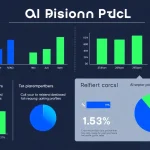Understanding Competitive Intelligence Services
In today’s fast-paced and ever-evolving business landscape, the ability to keep track of competitors and market trends is crucial for success. This is where competitive intelligence services play an invaluable role. Competitive intelligence (CI) encompasses a wide array of practices that help organizations gather, analyze, and interpret data about their competitors. Understanding the nuances of these services can greatly enhance a company’s strategic decision-making, market positioning, and ultimately, its profitability.
What is Competitive Intelligence?
Competitive intelligence is the process of collecting and analyzing information about competitors and the marketplace to gain insights that inform business strategies. Unlike espionage, which involves illegal tactics, competitive intelligence is lawful and ethical. It includes various forms of data gathering, from public resources to surveys and unofficial sources, where the end goal is to provide a thorough understanding of the competitive landscape.
The Importance of CI for Businesses
In an age where innovation and disruption are rampant, businesses cannot afford to remain stagnant. Competitive intelligence serves several essential functions in this regard:
- Strategic Planning: CI helps businesses anticipate market movements and plan accordingly.
- Risk Management: By understanding the competitive landscape, firms can mitigate risks related to market entry or product launches.
- Opportunity Identification: CI assists in pinpointing gaps in the market that can be exploited for growth.
- Enhanced Decision Making: Informed decisions are easier to make when backed by hard data and analytical insights.
Key Components of Effective Competitive Intelligence
To run an effective competitive intelligence program, organizations should focus on several key components:
- Data Sources: Identifying reliable and relevant information sources is critical.
- Analysis Techniques: Employing methodologies to interpret raw data is essential for meaningful insights.
- Communication: Insights gained from CI must be effectively communicated across the organization.
- Continuous Monitoring: The competitive landscape is not static; ongoing monitoring ensures that organizations stay informed.
How Competitive Intelligence Services Work
Data Collection Techniques
The backbone of competitive intelligence is the data collection process. There are numerous techniques employed to gather data:
- Surveys and Interviews: Directly engaging customers, suppliers, and partners can provide unique insights.
- Social Media Listening: Monitoring social media channels allows firms to understand public perception and competitor activity.
- Competitive Analysis Tools: There are various online tools available that help in tracking competitor websites, ad campaigns, and traffic.
- Market Reports: Acquiring relevant reports from research firms can deliver in-depth analyses of market trends and competitor positions.
Analysis Methods in CI
Once the data is collected, it must be analyzed through various methods:
- Sensitivity Analysis: Evaluates how different values of an independent variable affect a particular dependent variable.
- SWOT Analysis: Enumerates strengths, weaknesses, opportunities, and threats, providing a comprehensive view of a competitor’s market stance.
- Porter’s Five Forces: A framework for analyzing the competitive forces that shape an industry.
- Benchmarking: Comparing metrics against key competitors to identify performance gaps.
Interpreting Insights for Business Growth
The insights derived from competitive intelligence need to be actionable. Businesses must interpret these insights effectively to drive growth strategies:
- Strategic Development: Use insights to refine business strategies that capitalize on market trends.
- Customer Retention: Enhance products and services based on competitor analysis that meets or exceeds customer expectations.
- Innovation and Development: Direct R&D efforts toward areas of opportunity identified in the competitive landscape.
Benefits of Using Competitive Intelligence Services
Improving Market Positioning
By utilizing competitive intelligence services, companies can significantly improve their market positioning. CI helps organizations make informed decisions that position their offerings favorably against competitors. Enhanced visibility into competitors’ strengths and weaknesses allows businesses to fine-tune their value propositions, improve customer outreach, and address gaps in their service or product lines.
Identifying Growth Opportunities
With robust competitive intelligence, firms can uncover market opportunities that they may not have previously recognized. By analyzing market trends and competitors’ movements, businesses can pivot or expand their offerings to fill identified gaps, thus driving growth. This can include identifying new customer segments, spotting trends in customer preferences, and recognizing emerging technologies that may affect their market.
Staying Ahead of Competitors
The most significant advantage of competitive intelligence is its ability to keep organizations ahead of the curve. This proactive approach to assessing the competitive landscape ensures that businesses can respond quickly to changes that could impact their market position, whether through competitive actions or market dynamics. For example, understanding a competitor’s product launch strategy can allow a company to adjust their own timelines and offerings to retain their customer base.
Selecting the Right Competitive Intelligence Partner
Key Criteria for Evaluation
Choosing the right competitive intelligence partner can be a complex process. Organizations should consider several criteria when evaluating potential partnerships:
- Expertise and Experience: Look for firms with a proven track record in your industry.
- Range of Services: Ensure the CI partner provides a comprehensive suite of services tailored to your needs.
- Technology Utilization: Evaluate the technological tools they employ to gather and analyze data—are they leveraging AI, big data, etc.?
- Client references: Seeking testimonials or case studies can provide insights into the provider’s effectiveness.
Questions to Ask a CI Service Provider
Before entering into an agreement with a competitive intelligence service provider, it is important to ask pertinent questions, such as:
- What methodologies do you employ for data collection and analysis?
- How frequently will you provide updates and insights?
- Can you provide examples of past successes with similar companies?
- What metrics do you use to measure the success of your CI initiatives?
Understanding Pricing Models
Competitive intelligence services can vary in pricing models, so understanding these can help organizations choose the right provider:
- Monthly Retainers: Fixed monthly fees for ongoing services.
- Project-Based Fees: Charges based on specific projects or deliverables.
- Performance-Based Pricing: Costs depend on the success metrics agreed upon with the client.
Case Studies: Successful CI Implementations
Industry-Specific Examples
The effectiveness of competitive intelligence can be illustrated through specific case studies. Various industries have seen significant benefits:
- Technology Industry: A leading software company increased its market share by 10% through targeted CI initiatives that identified gaps in competitors’ service offerings.
- Retail Sector: A major retailer improved customer loyalty by utilizing CI to understand competitors’ promotional strategies and aligning their offerings accordingly.
- Healthcare: A pharmaceutical firm utilized CI to identify changing regulatory landscapes and adapt its compliance strategies, resulting in fewer penalties and fines.
Outcome Analysis of CI Strategies
Evaluation of competitive intelligence strategies is critical. Successful outcomes demonstrate how CI can influence business strategies:
- Improved market dynamics understanding led to a 15% increase in sales for a tech company.
- A retail chain optimized their inventory based on competitor analysis, reducing excess stocks by 30% and enhancing cash flow.
- A new service offering informed by competitive insights resulted in a 25% higher customer acquisition rate for a consulting firm.
Lessons Learned from CI Success Stories
Organizations can derive useful lessons from successful CI implementations, such as:
- The importance of integrating CI insights into strategic planning.
- Continuous monitoring of competitors should not end once initial data is gathered.
- Cultivating a company culture that values data-driven decision-making is crucial.



